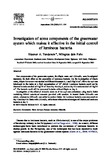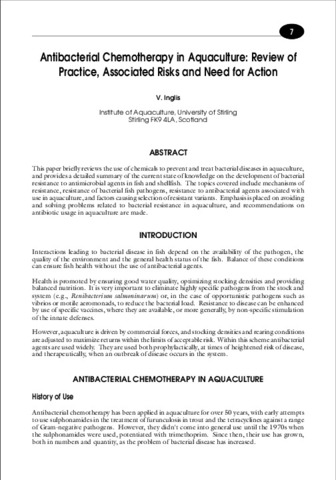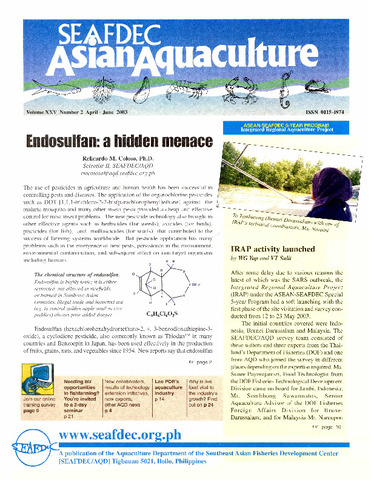Investigation of some components of the greenwater system which makes it effective in the initial control of luminous bacteria
- Global styles
- MLA
- Vancouver
- Elsevier - Harvard
- APA
- Help

閲覧/開く
日付
2003Page views
1,720ASFA keyword
AGROVOC keyword
Taxonomic term
Metadata
アイテムの詳細レコードを表示する
Share
抄録
Two components of the greenwater system, the tilapia water and Chlorella, were investigated separately for their effect on the population of luminous bacteria. For the investigation of tilapia water, Tilapia hornorum was stocked at different biomasses 0, 1 and 3 kg/10 m3. Vibrio harveyi was introduced to the tanks at a final concentration of 103 cfu/ml. Luminous bacteria could not be detected in tanks stocked at 3 kg/10 m3 from day 4 to day 6, and on day 6 in tanks stocked at 1 kg/10 m3. The bacteria could still be recovered in tanks without tilapia on day 6.
Investigation of the effect of chlorella alone on V. harveyi was undertaken using sterile flasks containing 500-ml autoclaved seawater provided with aeration. In treated flasks Chlorella was added, whereas no Chlorella was added to control flasks. No luminous bacteria were recovered on day 2 and day 3 in flasks with Chlorella, while those without the microalgae still harboured luminous bacteria at day 3.
Suggested Citation
Tendencia, E., & dela Peña, M. (2003). Investigation of some components of the greenwater system which makes it effective in the initial control of luminous bacteria. Aquaculture , 218(1-4), 115-119. https://doi.org/10.1016/S0044-8486(02)00524-0
Type
ArticleISSN
0044-8486Collections
- Journal Articles [1258]
Related items
Showing items related by title, author, creator and subject.
-
Antibacterial chemotherapy in aquaculture: review of practice, associated risks and need for action
Inglis, V. (Aquaculture Department, Southeast Asian Fisheries Development Center, 2000)This paper briefly reviews the use of chemicals to prevent and treat bacterial diseases in aquaculture, and provides a detailed summary of the current state of knowledge on the development of bacterial resistance to ... -
Endosulfan: a hidden menace
Coloso, Relicardo M. (Aquaculture Department, Southeast Asian Fisheries Development Center, 2003)A clean and healthy environment is paramount to human existence. While pesticide use has successfully sustained agricultural and food production in our lifetime as well as safeguarded human health by controlling insect ... -
Human health aspects of the use of chemicals in aquaculture, with special emphasis on food safety and regulations
Sinhaseni, Palarp; Limpoka, Malinee; Samatiwat, Ornrat (Aquaculture Department, Southeast Asian Fisheries Development Center, 2000)Safe and wholesome food is essential for good health. Therefore, when one considers health issues related to unsafe foods, recorded morbidity and mortality as well as economic losses in a population must be included. Due ...






